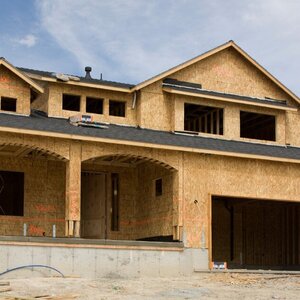Residential Real Estate News

Average Americans Spend 38 Percent of Monthly Income on Mortgage Payments
Residential News » Honolulu Edition | By Michael Gerrity | February 21, 2025 8:02 AM ET
For low-income families spend over 50 percent of income on mortgage payments each month
The latest NAHB/Wells Fargo Cost of Housing Index (CHI) highlights the ongoing affordability crisis in the U.S. housing market.
In the fourth quarter of 2024, a family earning the national median income of $97,800 needed to allocate 38% of its earnings to afford a mortgage on a median-priced new home. For low-income families--those earning just 50% of the median income--this figure surged to 76%.
The affordability challenge extends to existing homes as well. A typical family would need to spend 37% of its income on a median-priced existing home, while low-income households would have to devote 74% of their earnings to cover the same mortgage.
Urgent Policy Changes Needed
NAHB Chairman Carl Harris emphasized the need for policy reforms to address the housing affordability crisis. "The Cost of Housing Index is a wake-up call for policymakers to remove barriers that restrict new home construction," he said. NAHB's 10-point housing plan proposes key actions such as reducing regulatory burdens, improving building material supply chains, and reforming restrictive zoning laws to boost housing production.
Although the percentage of income required for a new home remained steady at 38% between the third and fourth quarters of 2024, affordability slightly declined for low-income families, increasing from 75% to 76%. Meanwhile, affordability for existing homes improved slightly, with CHI figures shifting from 38% to 37% for median-income families and from 75% to 74% for low-income households. This improvement was driven by a 2% drop in median existing home prices.
Housing Costs and Mortgage Trends
The fourth-quarter median new home price stood at $419,200, down slightly from $420,400 in the third quarter. Existing home prices followed a similar trend, decreasing from $418,700 to $410,100. However, the average 30-year mortgage rate edged higher, rising from 6.60% to 6.72%.
The U.S. Department of Housing and Urban Development (HUD) considers families "cost-burdened" when they spend more than 30% of their income on housing and "severely cost-burdened" when housing costs exceed 50% of earnings.
The CHI analyzes affordability across 176 metropolitan areas. In the fourth quarter, 10 metro areas had a CHI above 50%, indicating severe cost burdens for typical families, while 85 markets fell within the cost-burdened range of 31% to 50%. Only 81 markets had CHI figures at or below 30%, suggesting more affordable housing conditions.
Most and Least Cost-Burdened U.S. Markets
Top 5 Most Cost-Burdened Markets (Median-Income Families):
- San Jose-Sunnyvale-Santa Clara, CA - 87% of income needed for a mortgage
- Urban Honolulu, HI - 74%
- San Diego-Chula Vista-Carlsbad, CA - 69%
- San Francisco-Oakland-Berkeley, CA - 69%
- Naples-Marco Island, FL - 65%
Low-income families in these markets would need to spend between 129% and 174% of their income on housing.
Top 5 Least Cost-Burdened Markets (Median-Income Families):
- Decatur, IL - 16% of income needed for a mortgage
- Cumberland, MD-WV - 17%
- Springfield, IL - 17%
- Elmira, NY - 19%
- Peoria, IL - 19%
Low-income families in these areas would need to allocate between 31% and 39% of their income to housing costs.
The Path Forward
NAHB Chief Economist Robert Dietz underscored the urgency of tackling affordability challenges. "To create more attainable homeownership and rental opportunities, policymakers must eliminate regulatory barriers and foster a more supportive business environment for builders," he said.
The CHI continues to serve as a critical measure of housing affordability, highlighting the need for solutions that lower construction costs and expand access to affordable housing nationwide.
Sign Up Free | The WPJ Weekly Newsletter
Relevant real estate news.
Actionable market intelligence.
Right to your inbox every week.
Real Estate Listings Showcase
Related News Stories
Residential Real Estate Headlines
- Homebuyer Demand in America Drops to 5-Year Low in Early 2025
- Ownership More Affordable Than Renting in Most U.S. Markets
- The World's First Global Listings Service Launches, Called a GLS
- Home Prices Continue to Rise in 89 Percent of U.S. Metros in Late 2024
- Global Luxury Residential Prices Showed Gradual Improvement in Late 2024
- U.S. Construction Hiring Rate Drops to Lowest Levels in 5 Years
- Meet HAL, Real Estate Agent of the Future
- U.S. Homes Are Selling at Slowest Pace in 5 Years in Early 2025
- Pending Home Sales Dive Across America in December
- Greater Miami Residential Sales Uptick 3 Percent Annually in 2024
- U.S. Mortgage Applications Downtick in late January
- Under Biden, 2024 Marked the Slowest U.S. Home Sales Period in 30 Years
- Single-family Rent Growth in U.S. Slows to Lowest Rate in 14 Years
- Housing Starts Spike 15 Percent in America in Late 2024
- Day One: Trump Issues Executive Order on Emergency Price Relief for U.S. Housing
- 89 Percent of Homes Destroyed by Los Angeles Fires Were Single-Family Residences
- New AI-Powered Global Listings Service Under Construction
- World Property Media to Commence Industry Funding Round to Launch WPC TV
- Mortgage Rates in America Above 7 Percent, Again
- U.S. Residential Foreclosures Dip 10 Percent Annually in 2024
- U.S. Residential Asking Rents End 2024 at Lowest Levels in 3 Years
- World Property Markets to Commence Industry-wide Joint Venture Fundraise
- One Third of U.S. Homeowners Say They Will Never Sell
- Catastrophic Wildfires Devastating Tens of Billions of Dollars of Southern California Properties
- Is Greenland Soon Going to be Trump's Biggest Real Estate Deal?
- Greater Las Vegas Home Sales Jump 19 Percent Annually in December
- Active U.S. Residential Listings Spike 22 Percent in December
- U.S. Mortgage Rates Rise in Early 2025, Reach 6-Month High
- Greater Palm Beach Area Condo, Home Sales Collapse in November
- U.S. Pending Home Sales Increase Four Straight Months in November
- Global Real Estate Podcasts Coming to WPC TV Next Year
- Ireland Home Prices Spike 9 Percent in 2024
- More Americans Opting for Renting Over Homeownership in 2024
- BLOCKTITLE Global Property Tokenization Platform Announced
- Small Investors Quietly Reshaping the U.S. Housing Market in Late 2024
- Greater Miami Overall Residential Sales Dip 9 Percent in November
- U.S. Home Sales Enjoy Largest Annual Increase in 3 Years Post Presidential Election
- U.S. Housing Industry Reacts to the Federal Reserve's Late 2024 Rate Cut
- U.S. Home Builders Express Optimism for 2025
- Older Americans More Likely to Buy Disaster-Prone Homes





